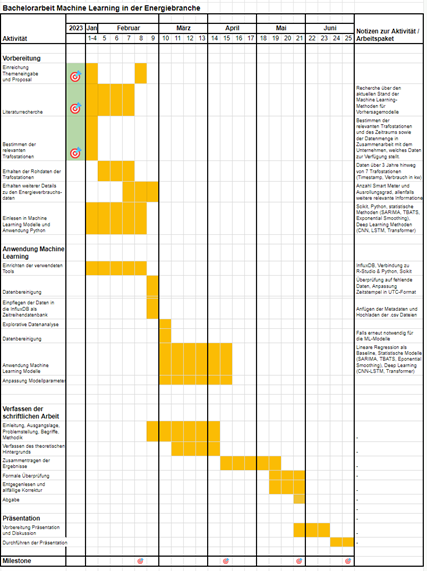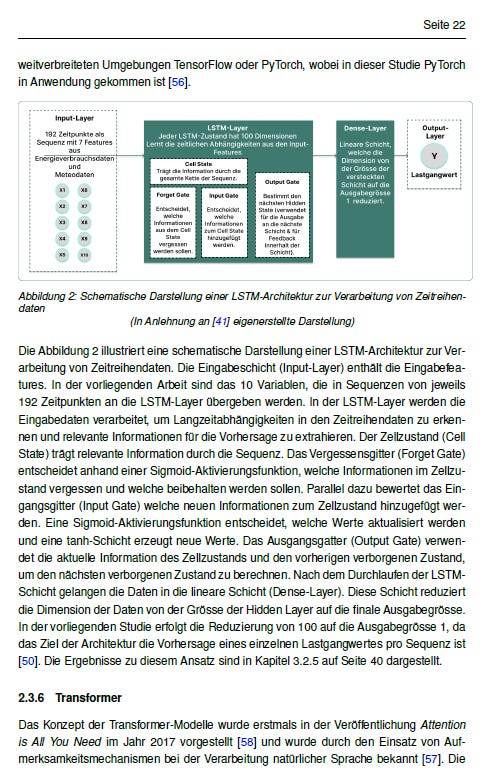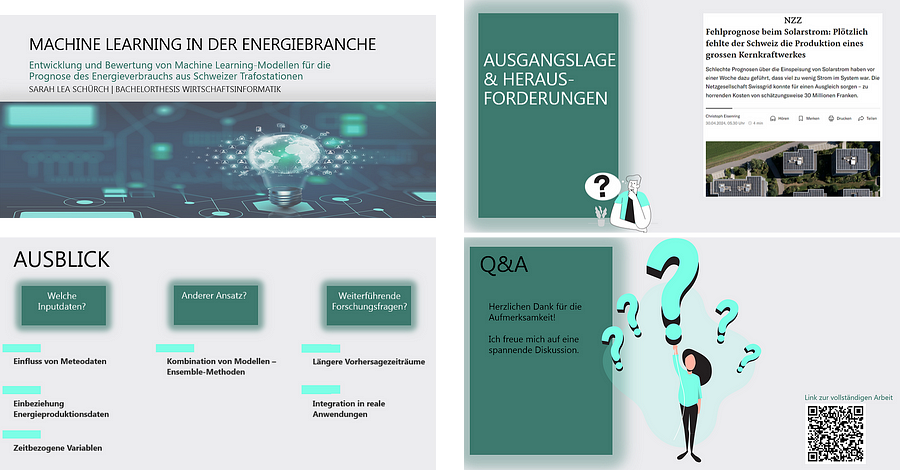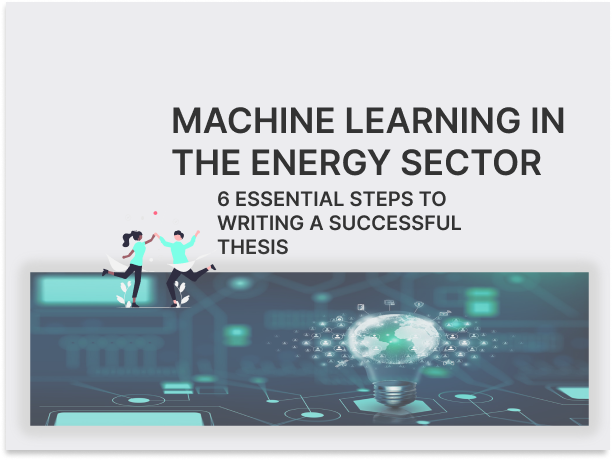How I Won First Prize with My Thesis on Energy Forecasting: 6 Essential Steps for Success
I love writing and composing such papers — but this may not be the case for everyone. In this article, I share the 6 key success factors that helped me to write such a successful thesis.
For my thesis, I compared and evaluated 6 different machine learning and deep learning models to predict energy consumption data. This is becoming increasingly important as our electricity system is undergoing major changes due to the increasing use of renewable energy. It is becoming more challenging to precisely match demand and usage — but this matching is necessary to ensure a stable energy supply.
I was awarded first prize for this thesis — the prizes were sponsored by IBM Switzerland. As a special highlight, I had the chance to shoot a short video about my thesis at IBM Switzerland last Friday — which was definitely an exciting experience. I love writing and composing such papers — but this may not be the case for everyone. In this article, I share the 6 key success factors that helped me to write such a successful thesis — even with a 60% job alongside university.
1 — Choosing the topic
Depending on the format of your university, you may have to work on your thesis for 4, 6 or even 12 months. It is therefore important that you choose a topic that you like and that interests you in the longer term.
I started with a brainstorming session and asked myself the following questions:
What interests me in my current work?
What goals do I have? Where do I want to develop professionally? What would I like to specialize in?
What interests me privately?
In which areas are there problems or unresolved issues currently? Which topics are currently trending and may be in the news? How could I contribute with my work?
Where do I have strengths? What skills and knowledge can I already contribute to the topic?
With these questions in mind, I compiled a list of topics that interest me and that I could imagine writing a thesis on. At this stage, however, I have only defined the topics as keywords and general themes.
Topics from the brainstorming phase
Smart City (e.g. analyses of smart city initiatives in Swiss cities), Artificial Intelligence (e.g. AI-based early detection of mental disorders, prediction of energy consumption data), Automation (e.g. implementation of Robotic Process Automation in a company), Productivity (e.g. use of artificial intelligence to automate workflows in companies), Marketing automation (e.g. IT tools landscape for foundations) etc.
Selected topic
Machine learning in the energy sector.
The launch of ChatGPT last January has significantly boosted the discussion about machine learning, deep learning and artificial intelligence among a wider audience. Some of it may be more hype and yet it is important to know something about these topics and show your knowledge of them. In addition, the energy sector and our power supply are currently undergoing major changes, as many countries are gradually switching to renewable energies. As I also wanted to have an interesting practical project in the field of machine learning/deep learning, I ultimately selected this topic.
2 — State of the Art
This step is about familiarizing yourself with the topic and gaining a solid understanding of the existing research. Start by reading up on the topic in depth by comparing relevant studies and summarizing the results. This will help you gain an overview of the current state of research and identify research gaps. With this overview and building on the research gaps, you can then formulate your research question and the thesis for your paper. For example, use Google Scholar, IEEE Xplore, ResearchGate, PubMed, JSTOR, SpringerLink or the direct Google search to find current scientific publications on your topic. When searching, use different keywords that are closely related to your topic. Think about whether you only need to search for research literature on your main topic or also on individual sub-topics. You can also use filters, for example, to search only for articles from the last 3 years.
Read only the abstract of scientific publications or use ChatGPT or a similar tool to briefly summarize the study to decide whether the study is relevant to your work. Another useful strategy is looking through the bibliographies in articles you have already read to find other key studies. This step also helps you to recognize problems that occur in the majority of research studies and to see how research papers are structured.
For example, I first researched overview articles on topics such as ‘Forecasting of Time Series Data’ and ‘Forecasting of Energy Consumption’. I then looked for specific articles on the individual methods I used in my work, such as ‘Energy Consumption Prediction with SARIMAX’, ‘Energy Consumption Prediction with TBATS’, ‘Energy Consumption Prediction with Exponential Smoothing’, ‘Energy Consumption Prediction with LSTM’, ‘Energy Consumption Prediction with Transformer’.
Through this step, I could identify seven research gaps and define my research question based on them. If you want to learn more about the identified research gaps or the individual methods, you can read one of my latest articles ‘Beginner’s Guide to Comparing Six Machine Learning Models for Energy Consumption Forecasting: A Five-Month Study (Part 1)’.
In the end, my definitive research question was: ‘Which Machine Learning Models are best suited for Forecasting Time Series Data of Energy Consumption from Swiss Transformer Stations?’
This step also helps you to discover gaps in your own knowledge. For example, I needed to deepen my understanding of PyTorch, LSTM and Transformer and therefore worked through some tutorials on these topics.
3 — Find a Company to Support you (optional)
Depending on the topic you choose for your thesis, it may be necessary to find a company to support you — especially if you rely on real data, as is often the case in data analysis, data science, machine learning or deep learning.
If you are not already working in a relevant company, it is important to start this step early. Depending on the industry, finding a company that shares their data directly, can be more challenging. My experience has shown that persistence is key: For example, I have already written to around 10–15 energy supply companies for a preliminary paper and was eventually able to have a conversation with two of them. In the end, one company agreed to support my work and provide me with energy consumption data. It is therefore also important not to be discouraged by a rejection or lack of response, but to contact other companies.
4 — Methodology
If your university does not already expect a fixed schedule in the proposal, create a schedule for yourself anyway. Think about how you can divide your work into manageable steps and which of these steps are interdependent. It is best to plan a time buffer for dependent tasks. Then start reading up on the topic and building up the knowledge you still lack.
If you use machine learning or deep learning as methods, also make sure that the university provides you with enough resources. For example, my university provided me a virtual Linux machine with two NVIDIA A100 80GB PCIe graphics cards (running CUDA version 12.4) to train my models efficiently.
Agile working may be a buzzword, but working according to this principle can also be very helpful. At each stage, ensure you have a version of the work that you could theoretically submit and work in iterative cycles. Firstly, this reduces the pressure and secondly, the sub-steps are constantly improved. For example, I started very early on to write an introduction, the initial situation, the problem statement and the overview of the current literature. In this way, I created a solid foundation and the big picture became much clearer to me early on, which in turn helped me in the use of the individual machine learning and deep learning models.
In addition, I initially concentrated on the energy consumption predictions with three models before I ventured into three more models. So, in the worst-case scenario, I could have submitted a complete paper with three models. If you want to know how the four different machine learning and two deep learning models performed in predicting the energy consumption data, I recommend one of my recent articles ‘Discovering the Best ML Model for Energy Forecasting: Which Tops the List? (Part 2)’.
5 — Writing the thesis
As I have already indicated, I recommend to start writing individual sections of your thesis early on. Think about which chapters you can already write without having all the results from the practical part. For example, you can write the introduction, the initial situation, the problem statement, the literature review, parts of the theory or even parts of the methodology at an early stage. This will help you get a better overview of the topic and create clarity for the next steps. Be sure to follow your university’s guidelines regarding formatting and structure. Read the guidelines carefully and make sure that you meet all requirements (e.g. correct citation of sources, correct format, inclusion of all expected chapters, etc.).
To make the writing process more efficient, I used a tool that allowed me to write my paper in OneNote. The tool then converted my work into Latex. This allowed me to organize my notes on the tasks and the text in one place without constantly worrying about formatting. I also avoided the typical disadvantages of Microsoft Word and ended up with a thesis that was aesthetically pleasing and correctly formatted. The tool is currently only available in beta version and is only available for test users. But I can definitely recommend it.
6 — Presentation and communication
After you have written your thesis, the next step is the presentation and defense of your thesis. Once you have put together your presentation, it is best to get an external opinion (e.g. a friend, fellow student, etc.). Since you are already very familiar with the topic, some terms and results may seem obvious to you but are not so clear to outsiders.
Also make sure that in your presentation you introduce the audience to the topic step by step and make the overall picture clear. Also check that all diagrams used are labeled, including clear headings and axis labels. This will ensure that the content is understandable even for those who are less familiar with the topic. I further recommend that you no longer use bullet points in presentations, but instead present lists in a different way.
Conclusion
Writing a successful thesis requires not only knowledge but also a strategic approach and persistence. I love writing and composing such papers — but this may not be the case for everyone. The 6 Key Factors helped me to write my thesis in such a way that it was awarded first prize. And I had an exciting experience getting an insight into IBM Switzerland and being in front of the camera to record a short video about my thesis. It was definitely worth completing the degree this way.







